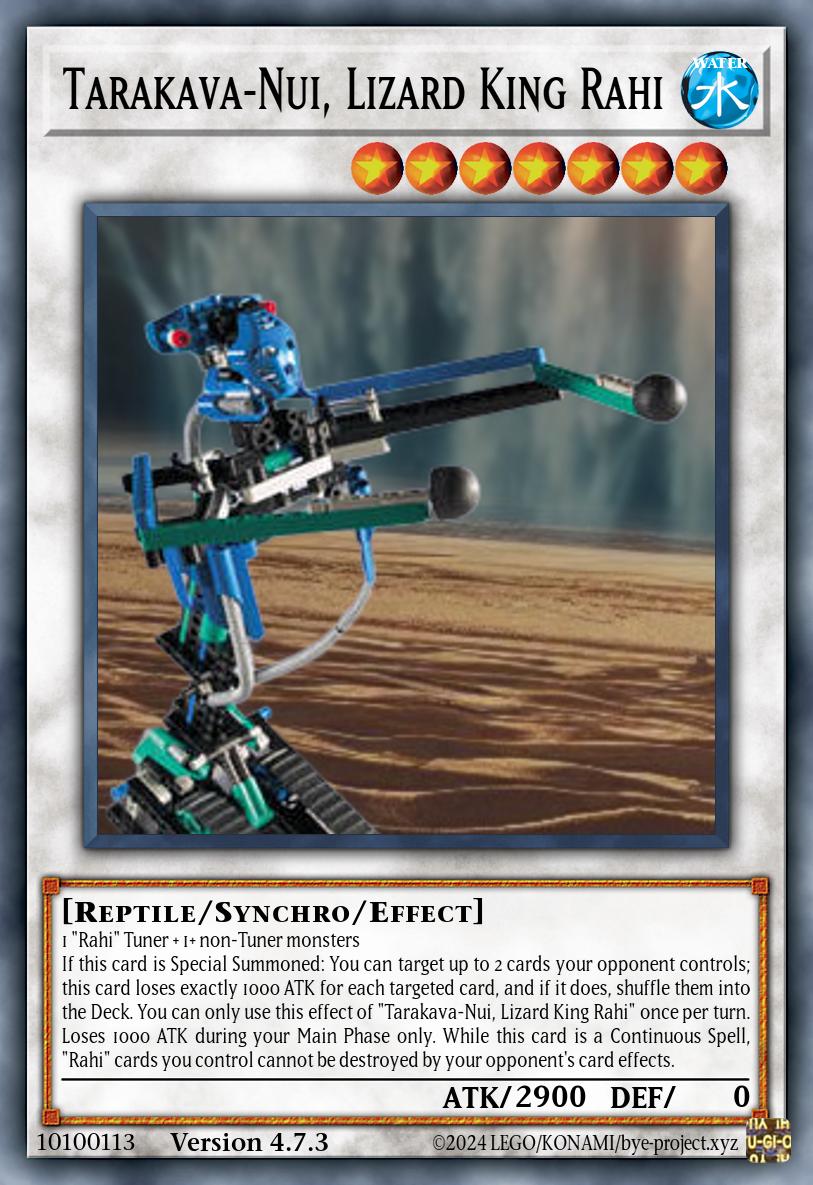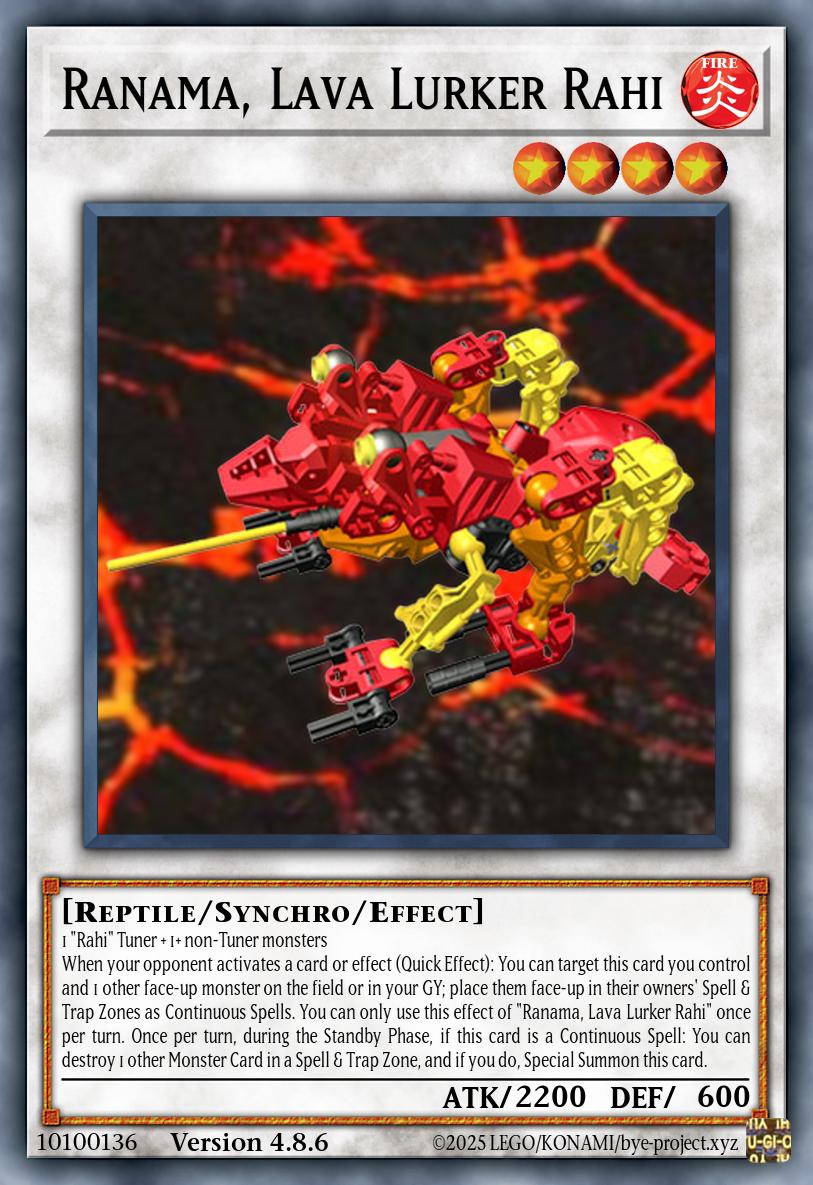There aren’t that many of them, but the Reptilians have surely invaded every single influential position in the Matoran Universe. What scaly visage is hiding beneath YOUR Turaga’s mask?
So yeah, welcome to the Reptile Rahi article.
See also:
- The Rahi Spreadsheet – The data all of this is based on
- The Shapes and Sizes of Rahi – Overview of all Rahi groupings
Current Members
A nice set of 5 Reptile Rahi is currently in the expansion, though with not much diversity on other card properties – all of them are Level 4 or higher, and the only Attributes present are FIRE, WATER, and EARTH.
Normal Pendulums
AKA the Tarakava family.

Tarakava, Lizard Rahi
Normal Pendulum MonsterLevel 6 | Scale 1/1 | WATER Reptile | ATK 2600 / DEF 1200[ Pendulum Effect ]
When an attack is declared involving an opponent’s monster: You can target 1 Reptile “Rahi” Monster Card in your Spell & Trap Zone; Special Summon it (but it cannot attack directly this turn), and if you do, destroy that opponent’s monster. You can only use this effect of “Tarakava, Lizard Rahi” once per turn.
—————————————-
[ Flavor Text ]
The first thing to remember about Tarakava is that even if you can’t see them, they are always there.

Sand Tarakava, Lizard Rahi
Normal Pendulum MonsterLevel 6 | Scale 8/8 | EARTH Reptile | ATK 2300 / DEF 1800[ Pendulum Effect ]
Reptile “Rahi” monsters in your leftmost or rightmost Main Monster Zone gain this effect.
●Once per turn (Quick Effect): You can place this card face-up in your Spell & Trap Zone as a Continuous Spell, or if it is a Pendulum Monster, you can place it in your Pendulum Zone instead.
—————————————-
[ Flavor Text ]
Sand Tarakava are slightly smaller than their Tarakava relatives. Their hunting method is to hide under the sand and wait for unsuspecting prey to come near.

Tarakava-Nui, Lizard King Rahi
Synchro Effect MonsterLevel 7 | WATER Reptile | ATK 2900 / DEF 01 “Rahi” Tuner + 1+ non-Tuner monsters
If this card is Special Summoned: You can target up to 2 cards your opponent controls; this card loses exactly 1000 ATK for each targeted card, and if it does, shuffle them into the Deck. You can only use this effect of “Tarakava-Nui, Lizard King Rahi” once per turn. Loses 1000 ATK during your Main Phase only. While this card is a Continuous Spell, “Rahi” cards you control cannot be destroyed by your opponent’s card effects.
These Lizards with a Determination to Fist are mostly characterized by their high ATK stats, though the Sand variant is a lot more balanced in that regard. For Pendulum Effects, other than the standard Type-based protection clauses, the regular Tarakava summons itself into battle in a way matching its signature surprise attacks, while the Sand Tarakava kind of performs the inverse operation by putting a Rahi into your Pendulum Zone at will. And the big Tarakava-Nui can just punch things straight back into the Deck at the cost of its own big ATK.
I feel like all of these effects could use some improvement, considering the Sand Tarakava one is even a Quick Effect on a Spell and thus massively against design principles, but let’s consider them as they are for now. An interesting theme I’m seeing here is a mix between beatsticks and effect-based removal on the same cards, almost like a middle ground between the proposed Beast and Aqua/Fish/Sea Serpent Rahi playstyles. A “missing link”, if you will. Fitting, isn’t it?
Others
Now let’s see if that idea holds up through the remaining two examples.

Bog Snake, Venomous Rahi
Pendulum Effect MonsterLevel 4 | Scale 5/5 | WATER Reptile | ATK 1500 / DEF 1500[ Pendulum Effect ]
Once per turn: You can destroy up to 2 “Rahi” Monster Cards you control, and if you do, Special Summon 1 Reptile “Rahi” Synchro Monster from your Extra Deck whose Level is less than or equal to their total Levels (this is treated as a Synchro Summon), then place it face-up in your Spell & Trap Zone as a Continuous Spell.
—————————————-
[ Monster Effect ]
If this card declares an attack: You can inflict 300 damage to your opponent for each Monster Card in your Spell & Trap Zone. If this card is destroyed: You can place 1 face-up Reptile “Rahi” Pendulum Monster from your Extra Deck in your Pendulum Zone, also you cannot activate the effects of “Bog Snake, Venomous Rahi” for the rest of this turn.
And immediately the Bog Snake makes things screwy by going into a completely different direction, namely effect damage. Because venom. This is more significant for its interaction with the Ghekula, its natural enemy, than with any other Reptiles, so maybe we shouldn’t think too much about this one.

Ranama, Lava Lurker Rahi
Synchro Effect MonsterLevel 4 | FIRE Reptile | ATK 2200 / DEF 6001 “Rahi” Tuner + 1+ non-Tuner monsters
When your opponent activates a card or effect (Quick Effect): You can target this card you control and 1 other face-up monster on the field or in your GY; place them face-up in their owners’ Spell & Trap Zones as Continuous Spells. You can only use this effect of “Ranama, Lava Lurker Rahi” once per turn. Once per turn, during the Standby Phase, if this card is a Continuous Spell: You can destroy 1 other Monster Card in a Spell & Trap Zone, and if you do, Special Summon this card.
The Ranama is our one and only Level 4 Synchro, and it does bring the desired combination of reasonably high stats and effect-based removal. That said, I feel like it tilts a bit more towards the latter, and, come to think of it, a toad should probably rather be placed in the Aqua Type for consistency’s sake. Hmmm.
Not much clarity on what exactly could set the Reptiles apart yet, but moving on.
Potential Members
The unimplemented part of the spreadsheet promises up to a quintupling of the Reptile Rahi pool, with 20 more entries waiting in the wings. Granted, some of those are the Rahi Nui and various worms that are unlikely to really get this Type in the final product, but that still leaves a fair number.
Level 4 and below
The selection of small (potential) Reptile Rahi starts at the Level 1 Spine Slug (already aptly covered in the DARK article), continues with the Level 2 Sand Frog (mentioned once in a serial), right into the Level 3 Fire Serpent (mentioned once in an online character bio with no direct archive available).
And after that three-card straight flush of things we don’t need to bother with, Level 4 finally brings some more noteworthy examples. Well, once we skip over the Air Serpents allegedly from Karda Nui, at least. Okay, the Stone Snake Krahka transformed into one single time probably also doesn’t count.
Which leaves us with two we’ve actually looked at before. The Crystal Climber could be a Beast or could be a Reptile, and is probably going to end up wherever its little mini-synergy with the Ice Bat can be implemented more smoothly (probably Beast though, to keep the Tri-Types together).
The Lohrak has a pretty good chance of becoming a Reptile since it is primarily a snake, and the same thing applies here as when we went over it for the Sea Serpents: Surprise attacks and poisonous flesh, kind of a decent fit mechanically.
Level 5
A surprising number of Reptiles are seemingly sized just between Matoran and Toa, which is a range of exactly this one Level.
A familiar one is the Cable Crawler, a bird-eating Rahi that kind of seems like a climbing lizard. Or a Beast, the lines tend to blur. What speaks for the Reptile typing is their vertigo-inducing Rhotuka power, which they use both to hunt their prey and stun larger creatures – a fine match with the kind of modular strategy considered so far. Assuming you can make the Rhotuka effects work, which might be a bit though in a Deck not focused on them. The tangentially mentioned Mud Crawler suffers from the same Beast-Reptile ambiguity, but if we even bother implementing it, it probably falls here as well due to the acid breath.
The Longfang is explicitly a Reptile, but also a bit disappointing in terms of abilities, since it’s just big and hunts with it jaws, which sounds more like a beatdown-focused Beast Rahi. Throws a little wedge into our plans.

The situation with the Swamp Stalker is similar, though it at least has the decency to be an ambush predator. Estimating the Level for this one is a little tricky because while we know the one that existed as a combiner model was mutated and enlarged, it’s not exactly clear what size the regular ones would be. Of course, that only matters if that version gets a card to begin with.
Finally, the Tunnelers make up for the above examples’ lack of abilities in spades, with their special power to absorb and reproduce anything used against them. This notably can and has been exploited as a weakness, so what it likely translates to is a mandatory trigger effect that copies the opponent’s effects somehow. There’s also the strange “madness” that causes them to change physically and go on a rampage, which could supply the beatdown component to round out this tricky effect in a hybrid Reptile strategy.
Level 6 and 7
Tahu reached the top of the barrier and looked at Lewa as if his brother Toa had turned into a giant swamp lizard.
BIONICLE Chronicles #4: Tales of the Masks
And that’s all it took to put the “Giant Swamp Lizard” into the BS01 Rahi list and therefore into my spreadsheet. No way we’re implementing this one, but presumably it would be Giant (Level 6-ish) Swamp (WATER/WIND) Lizard (Reptile). Shocking.
Speaking of which, the Red Serpent is a Maze of Shadows Rahi with electric powers, which in their one canon use had the remarkable effect of temporarily fusing Matau into a wall. And this right here is where I get a brilliant idea for a gimmick that could set Reptiles apart from all other Types of Rahi. It’s based on a pun, so get ready for this. Are you ready for this?

Scale Manipulation.
As in, Pendulum Scales. Because Reptiles have scales, the two main deck Tarakava already sort of do something like this, and the Red Serpent’s ability could also be very nicely represented by having it shove a monster into the backrow Vaylantz-style. The beatdown/removal hybrid could then be a secondary thing to ensure you have all the tools you need to win while playing around with such a weird gimmick.
The DARK Subterannean Worm is the kind of Worm that I’d rather have as a Reptile than as an Insect, but really both of those options kind of overlap the Normal Pendulums it’s supposed to be grouped with for the whole Rahi Nui package. Still unsure about this one, but its Attribute means it’s not too relevant for the broader Type anyway.
Night Creepers belong to the category of briefly described creatures, with six legs and seven feet (of length), overall sounding kind of like a lizard to me. Nothing of major interest here either.

Furnace Salamanders are said to be the size of a Toa when upright, but upon further consideration, that’s probably a poor reason to put them at the same Level – their swarming behaviour definitely suggests a smaller, less powerful creature at Level 4 or something. Size aside, they’re notable for their agile movements and painful bite, so it sounds like we have another candidate for mixing tricky effects and decent beatdown ability here.
Level 11 (Crystal Serpents)
The most magnificient (likely) Reptile Rahi are those created not by a Makuta, but by the master smith Artakha: The four Crystal Serpents. They spend most of their time dormant in the four corners of their maker’s island, but when active, amplifying light through their bodies lets them generate heat rays powerful enough to destroy a whole wave of Visorak at once. So between that impressive feat and their general legendary status and origins, they obviously have to get a pretty high Level. However, given how odd they are in the context of Rahi overall, I went with 11 rather than the 12 usually used for ginormic boss monster Rahi, just to make it a little weirder.
And while it’s subtle, the above description does contain a nice connection to the Pendulum Scale gimmick considered before: The serpents live in the four corners of the island, and where are the Pendulum Zones located? That’s right, the four corners of the field.
So what I’m thinking here is this: Each of the four serpents actually gets a distinct card to make a little Level 11 mini-archetype, and their effects allow them to be placed into both your and your opponent’s Pendulum Zones. Then, on some trigger, they wake up, Special Summon to your field, and just blow shit up immediately. It’s even more fitting because Crystal Beasts, while not Pendulums, are the OG “monsters in S/T Zone” gimmick deck, and what is a Crystal Serpent if not an off-Type Crystal Beast?
Conclusion
The Reptile Rahi are a mix of snakes, lizards, and generic predators that could just as well be argued to be Beasts. Unlike that Type, however, their hunting methods tend to involve “trickery” such as toxins or special abilities, suggesting something other than the most straightforward beatdown strategy. At the same time, they are also physically more formidable than the smaller end of the aquatic Types of Rahi, which kind of puts them at a balanced middle ground between being beefy beaters and control tools with disruption or removal effects.
That alone may not be enough to guarantee a solid identity, but several of them also have powers or traits suggesting a gimmick of backrow and Pendulum Scale manipulation (which coincidentally also fits with the already implemented Tarakava). So by focusing on that, we can establish a unique playstyle and win condition for Reptile Rahi decks, which the individual monsters’ jack-of-all-trades nature should help carry out in a variety of situations.
